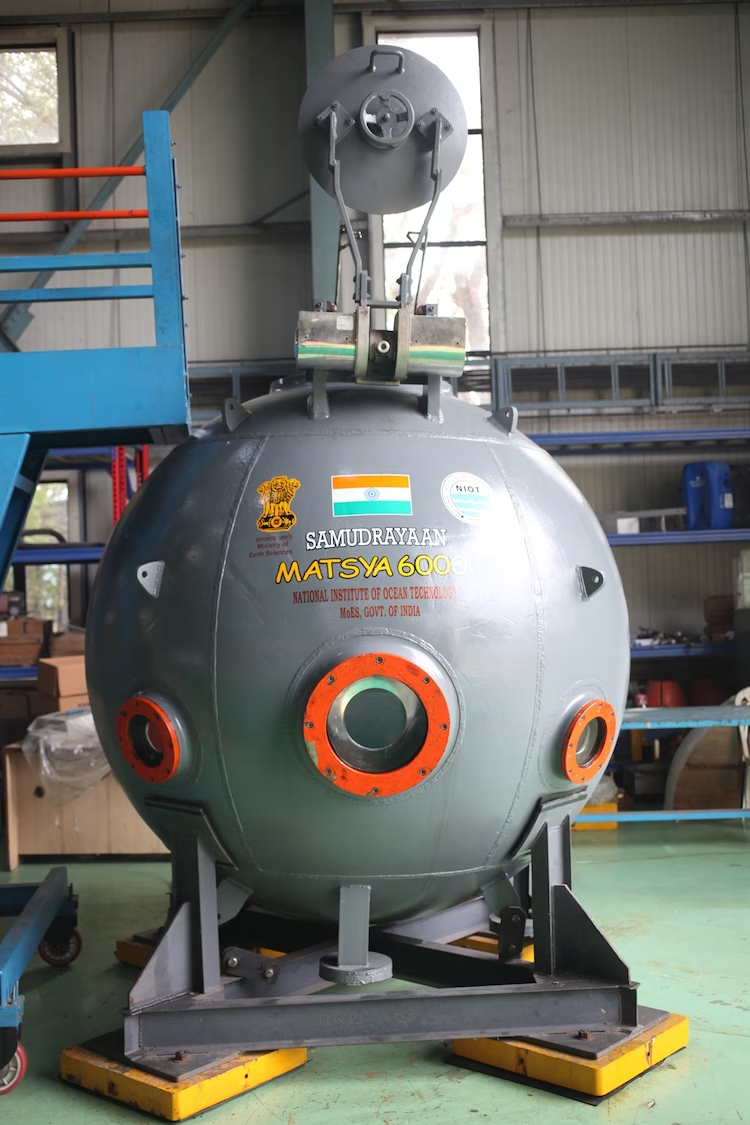Science & Technology
India’s Deep Ocean Mission
- 06 Nov 2023
- 7 min read
For Prelims: Deep Ocean Mission, Deep-Sea Mining, Samudryaan, Matysa6000, Varaha, Decade of Ocean Science, Biomimicry .
For Mains: Key Pillars of Deep Ocean Mission, Major Challenges in Deep Ocean Exploration.
Why in News?
India is gearing up for a historic Deep Ocean Mission to explore and harness the depths of the ocean, a frontier that remains largely uncharted and holds immense potential for scientific and economic benefits.
- Countries such as the U.S.A., Russia, China, France, and Japan have already achieved successful deep-ocean crewed missions.
What is the Deep Ocean Mission?
- About:
- Deep Ocean Mission (DOM) is an ambitious initiative of the Ministry of Earth Sciences (MoES) which aims to develop technologies and capabilities for deep sea exploration.
- Also, DOM is one of nine missions under the Prime Minister’s Science, Technology, and Innovation Advisory Council (PMSTIAC).
- Deep Ocean Mission (DOM) is an ambitious initiative of the Ministry of Earth Sciences (MoES) which aims to develop technologies and capabilities for deep sea exploration.
- Key Pillars of the Mission:
- Technological Advancements for Deep-Sea Mining and Crewed Submersibles
- Ocean Climate Change Advisory Services
- Innovations for Deep-Sea Biodiversity Exploration and Conservation
- Survey and Exploration of Deep-Ocean Minerals
- Harvesting Energy and Freshwater from the Ocean
- Establishment of an Advanced Marine Station for Ocean Biology
- Major Advancement in DOM Objectives:
- Samudryaan and Matsya6000: As a part of DOM, India’s flagship deep ocean mission, Samudrayaan, was initiated in 2021 by the Minister of Earth Sciences.
- With Samudrayaan, India is embarking on a groundbreaking crewed expedition to reach a depth of 6,000 m to the ocean bed in the Central Indian Ocean.
- This historic journey will be accomplished by Matsya6000, a deep-ocean submersible designed to accommodate a crew of three members.
- It is constructed from a titanium alloy, the sphere is engineered to withstand pressures of up to 6,000 bar.
- Samudryaan and Matsya6000: As a part of DOM, India’s flagship deep ocean mission, Samudrayaan, was initiated in 2021 by the Minister of Earth Sciences.
Note
The decision to target a depth of 6,000 meters holds strategic importance due to the presence of valuable resources like polymetallic nodules and sulphides. These resources, containing essential metals, are found between depths of 3,000 to 5,500 meters.
- Varaha- India's Deep-Ocean Mining System: The National Institute of Ocean Technology, an autonomous institute under MoES has conducted successful deep-sea locomotion trials using 'Varaha,' an underwater mining system, at a depth of 5,270 meters in the central Indian Ocean.
- These trials signified a pivotal moment in deep-sea resource exploration.
What are the Major Challenges in Deep Ocean Exploration?
- Oceanic Pressure Challenges: The high-pressure conditions in the deep ocean present a formidable challenge, exerting immense pressure on objects comparable to carrying a weight of about 10,000kg per square meter.
- Equipment Design and Functionality: The harsh conditions necessitate meticulously designed equipment made from robust materials. Electronics and instruments operate more efficiently in space or vacuum conditions, while poorly designed objects tend to collapse or explode underwater.
- Challenges of Landing: The soft and muddy surface of the ocean bed makes it exceptionally challenging for heavy vehicles to land or maneuver.
- Material Extraction and Power Demands: Extracting materials from the ocean floor requires significant power and energy to pump them to the surface.
- Remotely operated vehicles are ineffective in the deep oceans due to the absence of electromagnetic wave propagation.
- Visibility is limited, with natural light penetrating only a few tens of meters underwater, unlike space observations facilitated by telescopes.
- Other Compounded Challenges: Varied factors such as temperature variations, corrosion, salinity, and others further complicate deep-sea exploration, demanding comprehensive solutions.
Note
2021-2030 has been designated by the United Nations as the ‘Decade of Ocean Science’.
Way Forward
- Biologically-Inspired Designs: Draw inspiration from nature, such as marine organisms, for innovative engineering solutions.
- Biomimicry could lead to the development of structures and materials that are naturally suited to deep-sea conditions, offering increased resilience and adaptability.
- Energy Innovation: Develop sustainable power sources to support long-duration missions.
- This could include advancements in energy harvesting technologies like ocean thermal energy conversion, utilizing temperature gradients in the ocean for power, or exploring the potential of tidal and wave energy.
- Multi-Sensor Integration: Integrate diverse sensor technologies to compensate for limited visibility.
- This could involve combining sonar, lidar, and other imaging technologies to create a comprehensive picture of the deep-sea environment, allowing for better navigation and exploration.
- Environmental Impact Consideration: Ensuring that exploration initiatives are conducted with minimal impact on deep-sea ecosystems.
- Establishing international regulations and policies that govern deep-sea exploration to ensure responsible and ethical practices, balancing scientific advancement with environmental conservation.
UPSC Civil Services Examination Previous Year Question (PYQ)
Prelims
Q. With reference to the United Nations Convention on the Law of Sea, consider the following statements: (2022)
- A coastal state has the right to establish the breadth of its territorial sea up to a limit not exceeding 12 nautical miles, measured from baseline determined in accordance with the convention.
- Ships of all states, whether coastal or land-locked, enjoy the right of innocent passage through the territorial sea.
- The Exclusive Economic Zone shall not extend beyond 200 nautical miles from the baseline from which the breadth of the territorial sea is measured.
Which of the statements given above are correct?
(a) 1 and 2 only
(b) 2 and 3 only
(c) 1 and 3 only
(d) 1, 2 and 3
Ans: (d)
Q. What is blue carbon? (2021)
(a) Carbon captured by oceans and coastal ecosystems
(b) Carton sequestered in forest biomass and agricultural soils
(c) Carbon contained in petroleum and natural gas
(d) Carbon present in atmosphere
Ans: (a)





